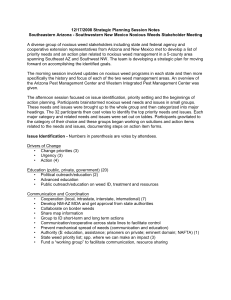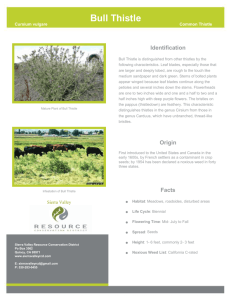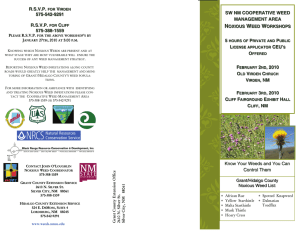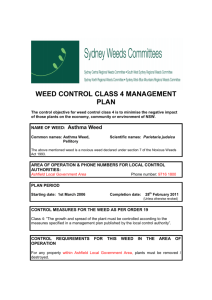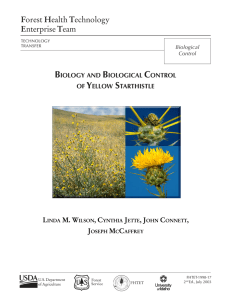Noxious Weeds, Methods and , Herbicides to Control Them
advertisement
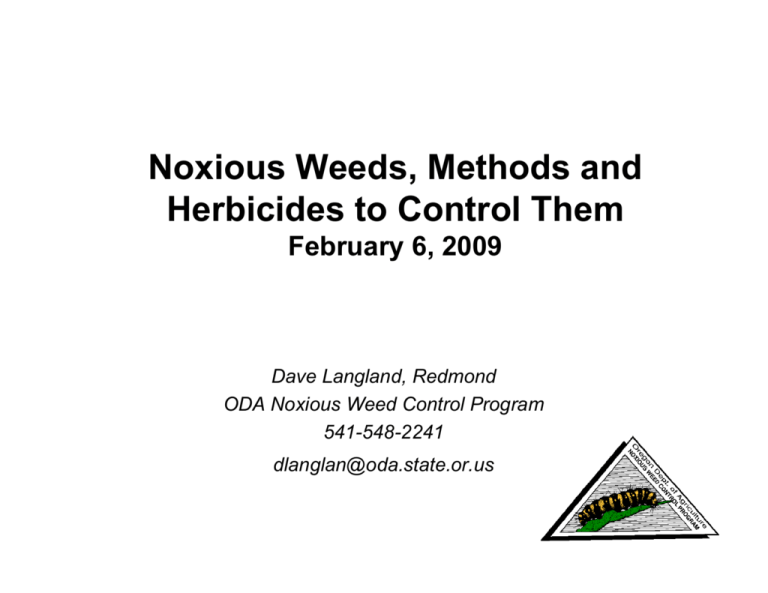
Noxious Weeds,, Methods and Herbicides to Control Them February y 6,, 2009 Dave Langland, Redmond ODA Noxious Weed Control Program 541-548-2241 dlanglan@oda.state.or.us OREGON DEPARTMENT OF AGRICULTURE NOXIOUS WEED CONTROL PROGRAM Tim Butler - Program Manager Survey & Detection OUR MISSION QuickTime™ and a TIFF (LZW) decompressor are needed to see this picture. Plumeless thistle Giant Hogweed QuickTime™ and a Photo - JPEG decompressor are needed to see this picture. QuickTime™ and a Photo - JPEG decompressor are needed to see this picture. QuickTime™ and a Photo - JPEG decompressor are needed to see this picture. Distaff thistle Purple starthistle Protect Oregon’s natural resources from the invasion and proliferation of exotic noxious weeds. Provide leadership and coordinate noxious weed management. Serve as a technical resource for noxious weed issues. Provide public outreach, education and awareness. Conduct weed risk assessments. Detect new invaders and implement rapid response control projects. Coordinate and implement biological control of weeds. Administer the State Weed Board grant program. Noxious Weed: any plant designated by the Oregon State Weed Board that is injurious to public health, agriculture, recreation, wildlife, or any public or private property. Regions - personnel & top projects Hawkweeds Squarrose knapweed Rapid p Response p & Treatment Paterson’s curse found in Douglas County. QuickTime™ and a Photo - JPEG decompressor are needed to see this picture. Treatment of Kudzu in Multnomah County. Outreach & Education Oregon Noxious Weed Strategic Plan provides an integrated approach for weed management. Dan Sharratt 541 562-5109 Biological Control 1978 Beth Myers 503 986-4621 Glenn Miller 541 937-2129 1. Giant hogweed 2 M 2. Meadow d h hawkweed k d 3. Gorse 1987 1. Squarrose knapweed 2. Plumeless thistle 3. Salt cedar Dave Langland 541 548-2241 1. Knapweeds 2. Dalmatian toadflax 3. Leafy spurge Bonnie Rasmussen 541 573-2506 Ken French 541 839-4929 1. Yellow starthistle 2. Paterson’s curse 3. Wooly distaff thistle 1. Perennial pepperweed 2. Mediterranean sage 3. Dalmatian toadflax Bob Barrett 541 850-9550 1. Knapweeds 2. Leafy spurge 3 Perennial pepperweed 3. WeedMapper - a cooperative database project that provides a repositor for weed repository eed sightings (OSU (OSU, BLM & USFS). Biological Control of Invasive Plants in the United States - a new book that covers all aspects of biocontrol. Oregon State Weed Board Successful biocontrol using the ragwort flea beetle. ODA manages 71 species of biocontrol agents against 33 weeds. - Helps guide ODA program - Designates weed ratings - Funded 251 grants totaling $4.4 million since 2000 - Represents stakeholders Salem staff : Tim Butler - Program Manager Tom Forney - Projects Coordinator Eric Coombs - Biocontrol Entomologist Jo Davis - Administrative Assistant Hole in a sea of purple loosestrife caused by Galerucella beetles (left) and Eustenopus weevil attacks yellow starthistle (right). L to R: Rear- Ken French, Tom Forney Middle - Eric Coombs, Dave Langland Front - Glenn Miller, Jo Davis, Beth Myers, Bonnie Rasmussen, Bob Barrett, Tim Butler, Dan Sharratt Contact us: Plant Division - Weed Control Oregon Department of Agriculture 635 Capitol St. NE Salem, OR 97301 503 986-4621 www.oregon.gov/ODA/PLANT Weed Board meeting Noxious Weed Designations: A- High priority for state B- Regional priority T- ODA target project Weed staff reviewing grants Noxious Weeds:Methods and Herbicides to Control Them • • • • • Prevention Cultural Physical g Biological Herbicides Prevention • Limit introduction of weeds and weed seeds • Early detection and control • Minimize disturbance • Monitor high-risk areas • Revegetate disturbed sites p • Evaluate effectiveness of prevention efforts Prevention Cultural Control • Manipulating management practices – Crop rotation – Pasture rotation – Animal selection (grazing) – Crop selection – Replanting seed purity Physical Control • • • • Tillage Burning Mowing H d roughing Hand hi Biological Control • • • • • Controversial Weed specific Must have agent Eff ti Effectiveness (none ( to t great) t) Will always have the weed Mill Creek, Prineville,OR 1997 Mill Creek, Prineville, OR 2000 Biological Control • • • • • • • • Knapweeds Yellow starthistle Leafy spurge Dalmation toadflax Medusahead rye P pepperweed White top Scotch Thistle Chemical Control • Controversial • Selective Control – Broadleaf only – Grasses only – All vegetation – Herbicides resistant weeds Chemical Control • Extra training q p • Extra equipment • Reporting in Oregon Thistles • • • • Scotch Thistle Smooth Distaff Woolly Distaff Bull Thistle • • • • Milk Thistle Musk Thistle Slender Flower Canada Thistle Thistles New Thistles • Plumeless • Taurin Knapweeds p • • • • • • • • • • • • • Spotted Knapweed Diffuse Knapweed Russian Knapweed Meadow Knapweed Brown Knapweed Black Knapweed Bighead g Knapweed p Squarrose Knapweed Short-fringed Knapweed B h l ’ B Bachelor’s Button tt Yellow Starthistle u p e Sta Starthistle t st e Purple Iberian Starthistle Knapweeds Mustards • • • • • Hairy Whitetop Lens-podded Whitetop Whitetop Perennial Pepperweed Dyers Woad Skeletonweed • • • • Nothing g Treat at flowering Bioconrol p g Fall herbicide spring seeding g • Treat at flowering • Westside?
